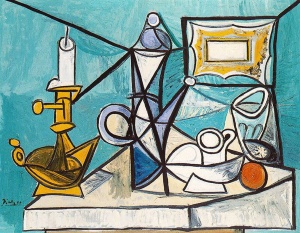Part 2 of this course will be looking into drawing elements in our own environment and so I begin a new chapter by researching further into still life after briefly touching still life and the necessary characteristics of a still life image during the preparatory work for assignment 1.
Still-life painting as an independent genre or specialty first flourished in the Netherlands during the early 1600s, although German and French painters were also early participants in the development (Metropolitan Museum of Art). In 16th century Europe, cut flowers, picked fruit, killed game, things that were dead or still began to appear as subjects for works of art. They were often meant to represent the temporality of life on Earth.
Pieter Aertsen
Butcher’s Stall with the Flight into Egypt (1551)
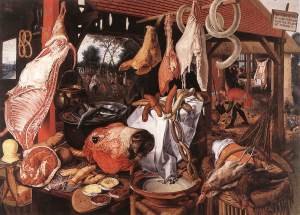
Source: http://www.ibiblio.org/wm/paint/auth/aertsen/butchers-stall/ Accessed on 01/02/2015
Pieter Aertsen was one of the first artists to paint “inverted still lifes,” works in which the still-life elements are placed prominently in the foreground, while the narrative elements are relegated to the background. The Butcher’s Stall is Aertsen’s masterpiece in this genre. A feast for the mind as well as the eyes, this remarkably executed painting abounds with rich symbolism. In the background to the left we see the Virgin on the Flight into Egypt dispensing charity to the faithful lined up for church, while to the right is the prodigal son in a tavern. (Pioch, 2002)
By the 17th century all sorts of non living objects were added to still lives in part due to the fascination of consumer goods in a fast growing mercantile society. Natural objects began to be appreciated as individual objects of study other than the typical religious associations which had been common within still life until this evolutionary period, as shown by Floris van Schooten:
Floris van Schooten
‘Nature morte au jambon’ (1612 to 1655)
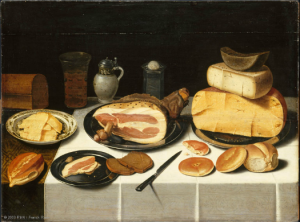
Source: http://www.louvre.fr/en/oeuvre-notices/still-life-ham Accessed on 01/02/2015
Compositionally, the ham appears to have been placed centrally; counterbalanced by the pyramid of cheeses, and other carefully-aligned food items. The white cloth and cheeses may refer to the Christian fasting period of Lent, when meat was forbidden; or could be a display of well-known examples of regional produce. The subjects are represented with great technical skill. Key forms within the objects indicate that this improvised meal is in the process of being eaten: the cheeses and ham are marked with irregular cuts from a knife, one of the pancakes has been nibbled, a plate has been prepared for someone, and the knife – balanced precariously on the edge of the table – looks as if it has just been put down. The picture conveys a sense of life and spontaneity, despite its somewhat rigid, conventional composition (Michèle Perny, 2003).
The 16th & 17th century witnessed an explosion of interest in the natural world and the creation of lavish botanical encyclopaedias recording new geographical discoveries. It also prompted the beginning of scientific illustration and the classification of specimens. Shells, insects, exotic fruits and flowers began to be collected and traded, and new plants such as the tulip (imported to Europe from Turkey), were celebrated in still-life paintings (Ebert-Schifferer, pp. 54-56)
Edward Collier
Still Life (1699)
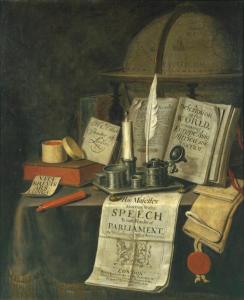
Source: http://www.tate.org.uk/art/artworks/collier-still-life-n05856 Accessed 01/02/2015
Still life works never became as common in Britain as on the continent. The objects depicted here are of high status and would have been owned by the educated and wealthy. Collier was a Dutch artist who specialised in still lifes and produced works for both the Dutch and the English markets. This picture is clearly intended for a British customer, since it includes manuscripts and texts written in English. (Hearne, 2001)
It appears that still life artists during the 16th & 17th century used their expertise knowledge and technique to portray their images. Often using symbolic subjects in reference to certain religious factors, the artists also paint their subjects in an analytical and detailed progression, making the final pieces very realistic and photographic-like.
By the 18th century, in many cases, the religious and allegorical connotations of still-life paintings were dropped and kitchen table paintings evolved into calculated depictions of varied color and form, displaying everyday foods. The French aristocracy employed artists to execute paintings of bounteous and extravagant still-life subjects that graced their dining table, also without the moralistic vanitas message of their Dutch predecessors.
Jean-Baptiste-Siméon Chardin
Still Life with Glass Flask and Fruit (1728)
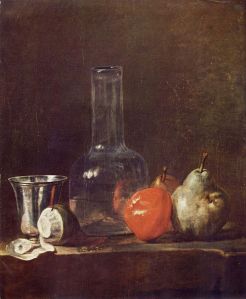
Source: http://www.wikiart.org/en/jean-baptiste-simeon-chardin/still-life-with-glass-flask-and-fruit Accessed 01/02/2015
Most of the early paintings have symbolism attached to the objects in them. That changed in the 19th century with the Impressionists and Post-Impressionists. Artists were no longer concerned with making a photo-realistic painting – there was no point since photography had been invented. Instead they experimented with colour, shapes, and the way paint was applied to the canvas, to create works which were beautiful in themselves – not because of what they meant.
Francisco De Goya
Still Life with Golden Bream (1812)
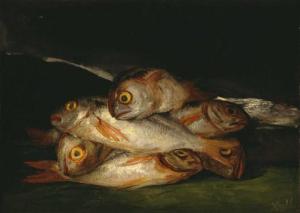
Source: http://www.mfah.org/art/detail/still-life-golden-bream/ Accessed 01/02/2015
Goya departs from traditional artistic depictions of dead animals, investing his still lifes with great pathos. The big staring eyes and lifeless glares make it feel as if Goya had the aim to portray mood rather than the image itself.
Pierre Auguste Renoir
Still life with fruit (1881)
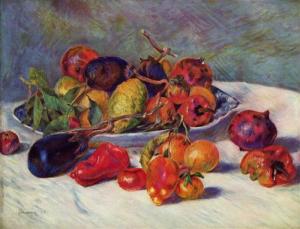
Source: http://www.wikiart.org/en/pierre-auguste-renoir/still-life-with-fruit-1881 Accessed 01/02/2015
Here, Renoir uses a variety of freely brushed bold and contrasting colours, depicting the beauty of the range of produce rather than portraying the objects having any particular meaning.
Paul Cézanne
Le vase paillé (1895)
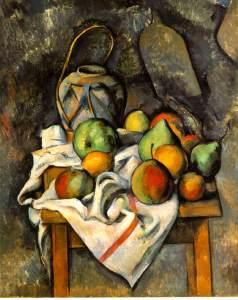
Source: http://www.ibiblio.org/wm/paint/auth/cezanne/sl/ Accessed 01/02/2015
Cezanne appears to create space and depth of perspective by means of planes of color, which are freely associated and at the same time contrasting. He creates many perspectives, and in this way volume comes once again to dominate the composition, no longer a product of the line but rather of the colour itself. The fruits and objects are readily identifiable, but they sensual or tactile appeal and no other function other than as decorative objects within the same flat space.
Paul Gaugin
Still life with profile of Laval (1886)
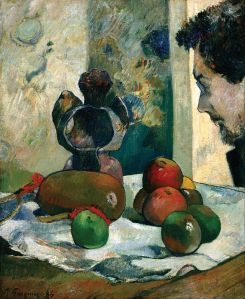
Source: http://www.imamuseum.org/blog/2012/01/24/a-modern-freundschaftsbild/ Accessed 02/02/2015
This combination of portrait and still life shows Gauguin’s ability to take the best of various artists he admired. For example, the abrupt way Laval’s face is cut off is a tribute to Edgar Degas’ off-centered, oddly-cropped compositions, while setup of the still life and the parallel brush strokes in the fruit has similarities to Paul Cézanne’s work.
The first four decades of the 20th century formed an exceptional period of artistic ferment and revolution.
Henri Matisse
Still life with Geraniums (1910)
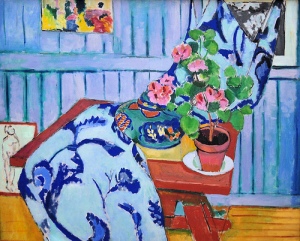
Source: http://artseverydayliving.com/blog/2011/08/art-walk-backyard/ Accessed 02/02/2015
During this time, artists were exploring the use of vivid colours and abstract shapes to explore still life as seen by Matisse who’s pots of geraniums are surrounded by elaborate patterns and designs in bright, contrasting colours. Perspective is lessened during this period as seen when focusing in on the geranium pot and how the elipse around the top of the pot compares to the linear base.
Avant-garde movements rapidly evolved and overlapped in a march towards nonfigurative, total abstraction. The still life, as well as other representational art, continued to evolve and adjust until mid-century when total abstraction eliminated all recognizable content (Ebert-Schifferer, p. 321)
Georges Braque
Bottle and fishes (1910-12)
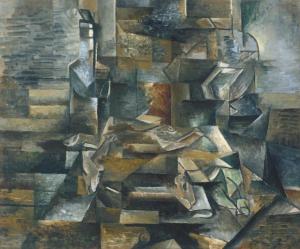
Source: http://www.tate.org.uk/art/artworks/braque-bottle-and-fishes-t00445 Accessed 02/02/2015
This new movement in abstract still life makes the image appear as if it is a college of fragments of a drawing. I find it quite difficult to depict the subjects but can just about make out a fish head towards the bottom and the neck of a bottle in the top left.
Claude Venard
Still Life (1955-6)
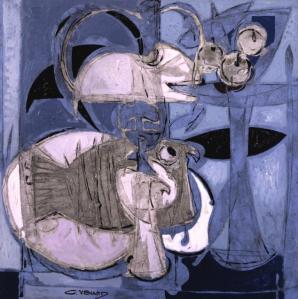
Source: http://www.tate.org.uk/art/artworks/venard-still-life-t00256/text-catalogue-entry Accessed 02/02/2015
Pablo Picasso
Still life with a lamp (1944)
Source: http://www.wikiart.org/en/pablo-picasso/still-life-with-lamp-1944 Accessed on 02/02/2015
Associated most of all with pioneering Cubism, alongside Georges Braque, Picasso also invented collage and made major contributions to Symbolism and Surrealism (The Art Story, 2014). Picasso used color as an expressive element, but relied on drawing rather than subtleties of color to create form and space; and sometimes added sand to his paint to vary its texture.
I really like this piece. I find it easier to depict than the work by Braque – use of bright contrasting colours and bold linear forms really jump out at you. It reminds me of a stain glassed window – as if Picasso has condensed colours into solid fragments and pieced everything back together again.
Sue Flask
Still Life (2001)
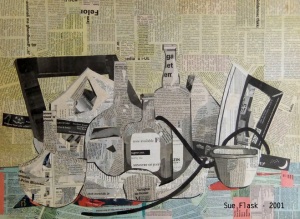
Source: http://www.saatchiart.com/art/Collage-Still-Life-2001/160844/1360154/view Accessed 02/02/2015
Flask has used ideas from Picasso’s collages to create her own, but rather than use wallpaper clippings and beautiful shades and colours, she has used everyday clippings from newspaper and magazines and carefully arranged them to portray various areas of tonal value.
Peter Jones
Ollie Monkey (2007)
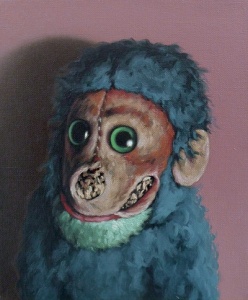
Source: http://www.theguardian.com/culture/gallery/2013/oct/19/10-best-contemporary-still-lifes?CMP=share_btn_link Accessed 02/02/2015
Monkeys were traditionally painted to hint at the beast within each man or woman, our link to untamed nature and the sexual danger within us. Jones’s Ollie and all his kin are nearing the end of their lifespan, worn out from love (or neglect), and their vulnerability is doubled because, as still-life subjects, they lie ready for inspection. (Petry, 2013)
I like that Jones has incorporated a sense of inquisition which leaves the viewer wondering why he has picked a worn out cuddly toy as the subject for his still life. Its big staring eyes and creepy expression captured my attention. The meaning behind this choice goes back to 17th and 18th century still life era where specific objects conjure up deeper meanings and symbols of life.
Ori Gersht
Time after time: Blow up No 3 (2007)
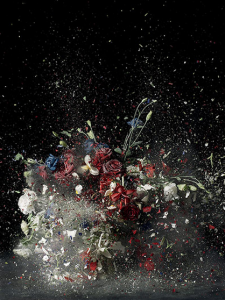
Source: http://www.theguardian.com/culture/gallery/2013/oct/19/10-best-contemporary-still-lifes?CMP=share_btn_link Accessed 02/02/2015
What have I learnt?
Evolution of still life summary:
- From narrative and symbolic meanings behind chosen subjects (Aertsen) or precious and valuable items (Collier) to pure interest and analysis of every day subjects, experimenting with colours and shapes (Matisse).
- Highly technical skilled paintings (van Schooten) to modern abstract pieces, sometimes hard to recogise specific objects (Braque).
- Use of solely oil painting still life (16th & 17th centuries) towards a wide range of materials such as collage (Picasso & Flask) to a variety of modern technology such as photography and video (Gersht)
The research I have found has broadened and enlightened my understanding of the still life genre and how it has developed over the last few centuries. I can now see how religious and social aspects used to influence still life artists and how the development of modern technology has enabled artists to use still life to explore expression rather than to create a narrative or deeper meaning to their work. Still life was solely oil paintings to show religious ideas or advertise wealth in the earlier periods, where as the idea of expressionism and surrealism has developed following the invention of photography, enabling artists to use a variety of materials and techniques to create abstract works. Today, still life continues to develop through use of video and filming, special camera effects and further technological advances.
References:
Druick, Douglas W.; Zegers, Peter Kort (2001). Van Gogh and Gauguin: the Studio of the South. Chicago: Art Institute of Chicago.
Ebert-Schifferer, Sybille. Still Life: A History, Harry N. Abrams, New York, 1998
McQuillan, Melissa. “Picasso, Pablo.” Grove Art Online. Oxford Art Online. Oxford University Press, accessed February 1, 2014
Metropolitan Museum of Art: Still-Life Painting in Northern Europe, 1600–1800 Available from: http://www.metmuseum.org/toah/hd/nstl/hd_nstl.htm
Museum of Fine Arts; Arts of Europe (No date) http://www.mfah.org/art/detail/still-life-golden-bream Accessed on 01/02/2015
(Online Image for Aertsen) http://www.ibiblio.org/wm/paint/auth/aertsen/butchers-stall/ Accessed on 01/02/2015
(Online Image for Chardin) http://www.wikiart.org/en/jean-baptiste-simeon-chardin/still-life-with-glass-flask-and-fruit Accessed on 01/02/2015
(Online Image for Flask) Saatchi Art (2015 ) http://www.saatchiart.com/art/Collage-Still-Life-2001/160844/1360154/view
(Online Image for Renoir) http://www.wikiart.org/en/pierre-auguste-renoir/still-life-with-fruit-1881 Accessed on 01/02/2015
(Online Image for Van Schooten) http://commons.wikimedia.org/wiki/File:Floris_van_Schooten_-_Breakfast_-_Google_Art_Project.jpg Accessed 01/02/2015
Perny, Michele (2003) from Louvre “Still life with ham” available from: http://www.louvre.fr/en/oeuvre-notices/still-life-ham Accessed on 01/02/2015
Perty, Michael(2010) in: THE GUARDIAN ‘The 10 best contemporary still lifes’ available from: http://www.theguardian.com/culture/gallery/2013/oct/19/10-best-contemporary-still-lifes?CMP=share_btn_link
http://www.tate.org.uk/art/artworks/collier-still-life-n05856
The Art Story (2014) Pablo Piccasso Synopsis. Available at: http://www.theartstory.org/artist-picasso-pablo.htm Last accessed 02/02/2015
